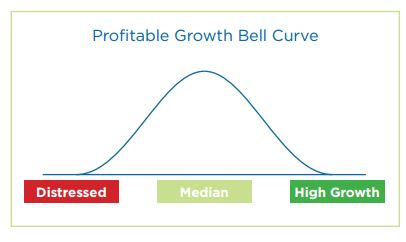Developing strategies for a family business is tough work. Executing the strategies is even tougher. So how can a family business be expected to take planning to a new level? By infusing innovation into strategy!
If yours is one of the few family firms that creates a strategic business plan, adding an element of innovation into the process will ultimately be more stimulating, thus increasing the probability of more meaningful plans that have true impact on the family business. Innovative strategies can also be more inspiring to execute. Infusing innovation into the strategic planning process is like the wind behind your back, lifting and supporting the strategy-development process to new heights.
Finding the Right Innovation for Your Business
Before diving into the question of how to infuse innovation into strategy, it is vital to understand the current economic health position of your family business. Determining the growth position will be a key determinant of the type of innovation thinking appropriate to aid in achieving the strategic initiatives you have developed.

On a classic bell curve of profitable growth, the High Growth outlier region indicates those family firms that are growing at double-digit rates, often times doubling every couple years. The Distressed outlier includes the few family firms struggling to make a profit and preserve the family business. The majority of family firms reside in the hump of the bell (the statistical zone of the mean and median) where they typically grow around the pace of the economy or in the single-digit range of 2 to 9 percent.
Innovation at the Extremes
Interestingly, the family firms residing in either extreme of the bell—those in distress or those in high-growth mode—are more apt to infuse innovation into their strategies. The high-growth family businesses, characterized by the need for cash to fund growth elements such as inventory and accounts receivable, often need to be innovative about how to ramp up operations to meet the high-growth demands. They find themselves trying to live up to the proverb “Make hay while the sun shines.” Innovative strategies to increase production become paramount: adding and blending a mix of more labor, more automation and more markets, both domestic and international.
For example, at a recent strategic planning session of a family business, the second-generation family leader celebrated the firm’s third consecutive year of growing more than 20 percent per year. He incentivized his leadership to “make more guesses on labor and capital needs, even if you over-hire or over-purchase capital.” A key strategic initiative emerged to develop a more flexible global production capability where they will be able to quickly shift production from North America, Asia and Latin America. In this high-growth phase, it is more important to build capacity while improving quality and delivery, all of which require more innovative approaches than a lower-growth company.
Family firms in trouble are open to trying new approaches because they know they have to change or potentially lose the business. These firms need rapid decision-making, more experimental tolerance, greater discipline on cost controls, and a shift towards compassion for the whole company, rather than individuals. If payroll reductions are required, there are adjustments that can be made for the benefit of the company without the shock of sudden layoffs. Along with moving people to part-time or temporary positions, a creative approach exercised by one family firm is called “tapping on the brakes.” It is a program that offers a steady wind-down of hours while still allowing time for outgoing employees to pass critical knowledge to others without abruptly departing.
Other firms in distress have infused creative financing into their strategies, engaging private equity firms that are more willing to take a minority ownership position. According to Warren Buffet, “A crisis is a terrible thing to waste.” These families should take advantage of their distressed situation and move from incremental changes in strategy to more radical or innovative changes since there is less to lose.
Innovation in the Midrange Family Business
The most difficult bell-curve position for family firms to embrace innovation in their strategy development is found in the large hump of the bell. Here is often found a mindset of “business as usual.” It is with this majority where the need exists to be more purposeful about looking at innovative ways to develop strategies.
While only a third of family firms are known to develop written strategic plans, those that do often stick to fairly standard approaches to the planning process: Conduct a SWOT (strengths, weaknesses, opportunities, threats) analysis; check trends; review financials; and identify key strategic initiatives and performance indicators. What is often missing is a robust strategy development session forcing the planning team to look at things differently, suggest new approaches, think beyond best practices and try new concepts.
Some of the ways for these stable, status-quo-satisfied family firms to infuse innovation into strategy development are to:
- Ask more probing, provocative questions.
- Strive to develop best practices in their business or industry instead of copying what others may proclaim are current best practices.
- Place a family member on an innovation team either as the leader or member of the team.
Asking the Right Questions
Before diving head-first into a planning session, develop a list of relevant questions to trigger different perspectives and encourage creative thinking about the firm’s strategy.
For instance, when one family continued to lose market share from their traditional direct sales channel, they began to ask:
- Why do we continue to market our products the same way when the channels of distribution are rapidly changing?
- How can we adapt to the digital world more quickly?
- How can we make money or “monetize” in the digital world?
These questions led to the development of a Digitalization Task Force that included millennials working in the business and a young marketing professor to assist the family in creating a multi-pronged approach to the digital world. New service offerings for developing websites, conducting focus group research and forming a digital communication agency have already emerged from this team.
Another family presented the following questions to its strategic planning team during an off-site planning session:
- Will our vision and mission help us achieve a long-term family business?
- What are 10 ways we can reimagine and package our product offerings in new ways?
- What are we doing to reboot our offerings and marketing for the new realities of customers buying in dramatically different ways?
- How are we going to take advantage of multimedia channels?
- What are we trying to do for our customers? What do our customers really want?
- When it comes to customers, how is our organization shifting from a “how many” to “who” focus?
Other family firms follow questions that management gurus like former General Electric chairman Jack Welch have posed to public companies. Welch has a series of competitive questions that could help a family firm trying to break out of their status-quo mentality:
- What does your competitive environment look like?
- In the last three years, what have your competitors done?
- In the same period, what have you done to them?
- How might they attack you in the future?
- What are your plans to leapfrog over them?
Making Your Own Best Practices Even Better
Meeting current best practices keeps you even with competition. Creating new best practices advances you past the prevailing conventional wisdom.
When Jimmy John Liautaud, founder of Jimmy John’s sandwich company, tried to beat Subway in the marketplace with higher quality ingredients, he learned that the consumer only placed an incremental value on the substantially higher quality meats, cheeses and other ingredients that Jimmy John’s offered. They had already achieved the industry level of best practices in quality, operations and delivery time, so how could they differentiate themselves?
After much strategic discussion with many of their family-owned franchises, Jimmy John’s decided to move past the current best practice for delivery time. This led to their “freaky fast” approach. Liautaud claims this changed everything. By upping their game in this key element to become the quickest sandwich delivery in the business, this strategy led to greater innovative thinking on improving order taking, sandwich making, delivery training and menu adjustments.
Infusing Family into the Process
When a family member is involved in the innovation process, it brings a heightened awareness to the process and forms an advantage for family businesses. A family member typically brings clout and an insider level of persuasion to effectively work through “messy” and often politically dicey development tasks, like securing funds for research and development or building a quick prototype. The presence of such innovation champions in the family leadership is essential for family businesses to grow beyond their core business. Of course, such champions require fundamental management skills to see innovation through. A good idea is almost never enough.
Matt Schad, a fourth-generation member of the family-run Nucraft Furniture Company, is a great example of an innovation champion. The business creates high-end office furniture found in some of the most prestigious law firms and government agencies in the United States. Schad worked as an attorney with a Washington, D.C. law firm before joining Nucraft, where he rose to lead new product development. Though admittedly not a designer himself, he has the family position, business savvy and law experience to maneuver new products through the organization effectively. By combining inside talent and external design support, along with his deep law-firm experience, Schad has created a steady stream of products that have driven revenue growth and won high-profile industry awards. Schad was recently named Chief Executive Officer, partially because of his success in creating new creative offerings.
It takes multiple approaches to infuse innovation into family business strategy. Asking provocative questions, developing your own best practices and inserting family leaders are just three ways to improve the odds of incorporating creative thinking into strategy development. Adding innovation should not be considered an additional step in the strategic planning process, but rather an integral part of the process.
And as one family leader pointed out: “Innovative thinking is not only critical for advancing the family business, it’s a lot more fun!”

